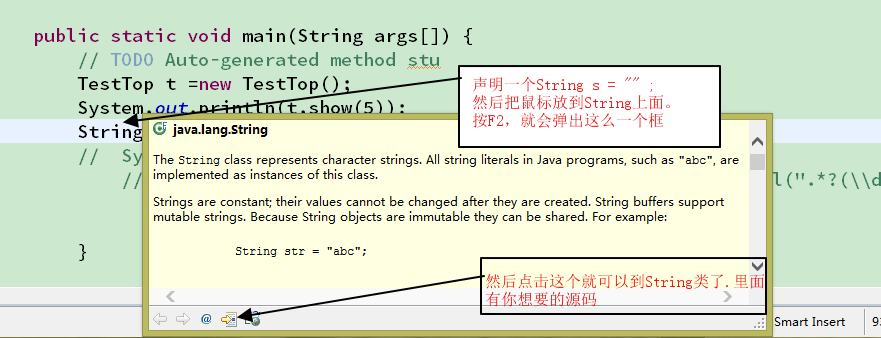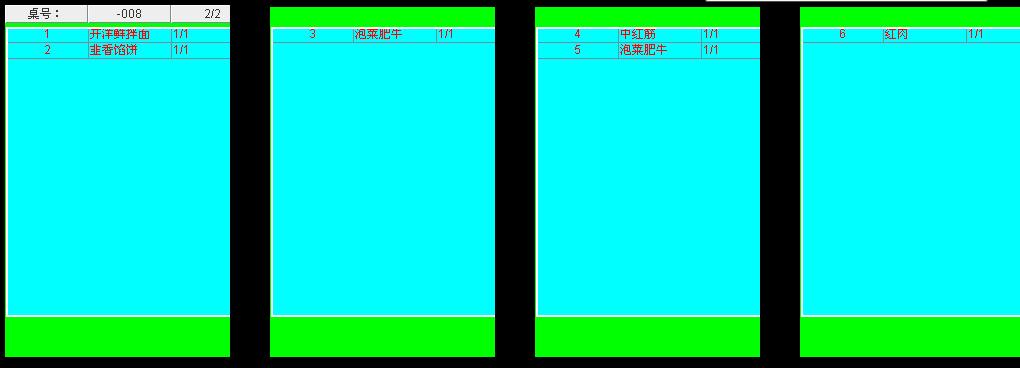如何实现一个 字符串类 ??
老师让我自己编写String的一些方法,让后实现一个字符串类,结果我只是把编写的那些方法放在一个类里面了,老师说不可以,他不让用String的原有方法,还要有什么构造函数,谁能给出一些思路啊,解释一下什么意思啊?? string --------------------编程问答-------------------- 不知道你说的抽象,还是你老是说的抽象。String应该是不能继承的,
StringBuffer应该可以。
要是我继承一个StringBuffer,然后任务完成。 --------------------编程问答-------------------- 主要就是对String的方法自己从新编写,实现一个字符串类,字符串类是怎么实现的??? --------------------编程问答-------------------- 就是重写String类的方法,这个简单,你看那些方法都是来实现什么方法,你就重写这个方法名,在这个方法里自己写要来实现的功能,只要是重写!!! --------------------编程问答-------------------- 看看String的源码就明白了 --------------------编程问答-------------------- 已经重写完了,然后我把这些一堆的函数全放在一个类里面了,老师说不行,他说让我实现的是一个 字符串类~~这我就不太明白怎么弄了,给点思路啊………… --------------------编程问答-------------------- 不让用原生的String类,那就是让你们自己实现一个String类吧?你看原来的怎么写的,就用自己的代码重写一下吧.. --------------------编程问答-------------------- 他的意思可能谁叫你override String方法 --------------------编程问答-------------------- 先去看看api吧,。、。http://www.ostools.net/apidocs/apidoc?api=jdk-zh
源码可以在jdk里面找到...

eclipse上面弄的。 --------------------编程问答-------------------- 给你把java.lang.String简化一下
MyString类:
public class MyString implements MyCharSequence{
/** The value is used for character storage. */
private final char value[];
/** The offset is the first index of the storage that is used. */
private final int offset;
/** The count is the number of characters in the String. */
private final int count;
public MyString() {
this.offset = 0;
this.count = 0;
this.value = new char[0];
}
// Package private constructor which shares value array for speed.
MyString(int offset, int count, char value[]) {
this.value = value;
this.offset = offset;
this.count = count;
}
/**
* Returns the length of this string.
* The length is equal to the number of <a href="Character.html#unicode">Unicode
* code units</a> in the string.
*
* @return the length of the sequence of characters represented by this
* object.
*/
@Override
public int length() {
return count;
}
/**
* Returns the <code>char</code> value at the
* specified index. An index ranges from <code>0</code> to
* <code>length() - 1</code>. The first <code>char</code> value of the sequence
* is at index <code>0</code>, the next at index <code>1</code>,
* and so on, as for array indexing.
*
* <p>If the <code>char</code> value specified by the index is a
* <a href="Character.html#unicode">surrogate</a>, the surrogate
* value is returned.
*
* @param index the index of the <code>char</code> value.
* @return the <code>char</code> value at the specified index of this string.
* The first <code>char</code> value is at index <code>0</code>.
* @exception IndexOutOfBoundsException if the <code>index</code>
* argument is negative or not less than the length of this
* string.
*/
@Override
public char charAt(int index) {
if ((index < 0) || (index >= count)) {
throw new StringIndexOutOfBoundsException(index);
}
return value[index + offset];
}
/**
* Returns a new string that is a substring of this string. The
* substring begins at the specified <code>beginIndex</code> and
* extends to the character at index <code>endIndex - 1</code>.
* Thus the length of the substring is <code>endIndex-beginIndex</code>.
* <p>
* Examples:
* <blockquote><pre>
* "hamburger".substring(4, 8) returns "urge"
* "smiles".substring(1, 5) returns "mile"
* </pre></blockquote>
*
* @param beginIndex the beginning index, inclusive.
* @param endIndex the ending index, exclusive.
* @return the specified substring.
* @exception IndexOutOfBoundsException if the
* <code>beginIndex</code> is negative, or
* <code>endIndex</code> is larger than the length of
* this <code>String</code> object, or
* <code>beginIndex</code> is larger than
* <code>endIndex</code>.
*/
public MyString substring(int beginIndex, int endIndex) {
if (beginIndex < 0) {
throw new StringIndexOutOfBoundsException(beginIndex);
}
if (endIndex > count) {
throw new StringIndexOutOfBoundsException(endIndex);
}
if (beginIndex > endIndex) {
throw new StringIndexOutOfBoundsException(endIndex - beginIndex);
}
return ((beginIndex == 0) && (endIndex == count)) ? this :
new MyString(offset + beginIndex, endIndex - beginIndex, value);
}
/**
* Returns a new character sequence that is a subsequence of this sequence.
*
* <p> An invocation of this method of the form
*
* <blockquote><pre>
* str.subSequence(begin, end)</pre></blockquote>
*
* behaves in exactly the same way as the invocation
*
* <blockquote><pre>
* str.substring(begin, end)</pre></blockquote>
*
* This method is defined so that the <tt>String</tt> class can implement
* the {@link CharSequence} interface. </p>
*
* @param beginIndex the begin index, inclusive.
* @param endIndex the end index, exclusive.
* @return the specified subsequence.
*
* @throws IndexOutOfBoundsException
* if <tt>beginIndex</tt> or <tt>endIndex</tt> are negative,
* if <tt>endIndex</tt> is greater than <tt>length()</tt>,
* or if <tt>beginIndex</tt> is greater than <tt>startIndex</tt>
*
* @since 1.4
* @spec JSR-51
*/
public MyCharSequence subSequence(int beginIndex, int endIndex) {
return this.substring(beginIndex, endIndex);
}
}
MyCharSequence接口:定义我要生成的字符串类的基本操作
public interface MyCharSequence {
/**
* Returns the length of this character sequence. The length is the number
* of 16-bit <code>char</code>s in the sequence.</p>
*
* @return the number of <code>char</code>s in this sequence
*/
int length();
/**
* Returns the <code>char</code> value at the specified index. An index ranges from zero
* to <tt>length() - 1</tt>. The first <code>char</code> value of the sequence is at
* index zero, the next at index one, and so on, as for array
* indexing. </p>
*
* <p>If the <code>char</code> value specified by the index is a
* <a href="Character.html#unicode">surrogate</a>, the surrogate
* value is returned.
*
* @param index the index of the <code>char</code> value to be returned
*
* @return the specified <code>char</code> value
*
* @throws IndexOutOfBoundsException
* if the <tt>index</tt> argument is negative or not less than
* <tt>length()</tt>
*/
char charAt(int index);
/**
* Returns a new <code>CharSequence</code> that is a subsequence of this sequence.
* The subsequence starts with the <code>char</code> value at the specified index and
* ends with the <code>char</code> value at index <tt>end - 1</tt>. The length
* (in <code>char</code>s) of the
* returned sequence is <tt>end - start</tt>, so if <tt>start == end</tt>
* then an empty sequence is returned. </p>
*
* @param start the start index, inclusive
* @param end the end index, exclusive
*
* @return the specified subsequence
*
* @throws IndexOutOfBoundsException
* if <tt>start</tt> or <tt>end</tt> are negative,
* if <tt>end</tt> is greater than <tt>length()</tt>,
* or if <tt>start</tt> is greater than <tt>end</tt>
*/
MyCharSequence subSequence(int start, int end);
/**
* Returns a string containing the characters in this sequence in the same
* order as this sequence. The length of the string will be the length of
* this sequence. </p>
*
* @return a string consisting of exactly this sequence of characters
*/
public String toString();
}
--------------------编程问答-------------------- 意思就是你自己写代码实现String类的功能,比如String类有一个方法toUpperCase(),功能是把字符串转化为大写;你需要自己去实现他,而不是用线程的方法。
--------------------编程问答-------------------- 意思就是你自己写代码实现String类的功能,比如String类有一个方法toUpperCase(),功能是把字符串转化为大写;你需要自己去实现他,而不是用现成的方法。
补充:Java , Java SE




